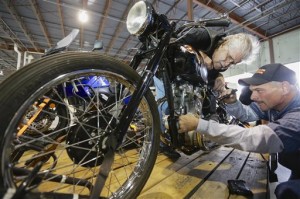 A Nebraska man who owned a 1953 Triumph Tiger 100 motorcycle lost the bike almost 50 years ago and received the surprise of his life when the motorcycle was returned to him. The owner ,Donald DeVault, 73 years old, hugged the man who brought the bike back to him and took it for a spin on the parking lot.
A Nebraska man who owned a 1953 Triumph Tiger 100 motorcycle lost the bike almost 50 years ago and received the surprise of his life when the motorcycle was returned to him. The owner ,Donald DeVault, 73 years old, hugged the man who brought the bike back to him and took it for a spin on the parking lot.
According to an article, DeVault had owned the bike for only a year or two when it was taken from his fenced backyard. DeVault filed a report in February 1967 awas shocked to learn the motorcycle had been found by California authorities at the Port of Los Angeles. The bike was about to be shipped to Japan when agents checking the vehicle identification number discovered it had been reported stolen.
The motorcycle that was valued at $300 in 1967 is now considered a vintage and valued at about $9,000. DeVault owns a Harley-Davidson and a Kawasaki motorcycle, but says the newly returned Triumph motorcycle is only reserved for special rides.
Other motorcycle owners may not be as lucky as DeVault, and some thieves are quite unexpected.
The Motorcycle Safety Foundation offers the following tips to prevent motorcycle theft:
- Lock your ignition and remove the key. Most bike thefts occur when the ignition is shut off, but not locked.
- Lock the forks or disk brakes with locks that have large, brightly colored tags.
- If traveling with other riders, lock motorcycles together when not in use.
- If riding alone, lock your bike to a secure, stationary object that can’t be easily dismantled, such as a light pole.
- Add a loud alarm to your motorcycle.
- When traveling and spending the night at a hotel, locate an outdoor security camera and park your bike in the camera’s view. If this is not possible, park your bike close to your room.
- Keep an eye on your bike. When parking at a public event, check your motorcycle periodically, especially immediately after leaving your bike, to make sure there are no suspicious individuals lurking about.
- If parking in a garage, block your bike with automobiles, close the garage door and make sure it is locked.
- Don’t store your title in your bike’s storage compartment, tank bag, or saddlebag. The safest place for your title is at home.
- Have you motorcycle uniquely marked and then take multiple photographs of the unique marks of your bike. If thieves take your bike, you can inform authorities about the unique marks of the motorcycle.
- Keep your bike registration and insurance identification card on you when you ride.
- Be careful about giving out private information on where you live, work or play.
If you use a trailer to transport your motorcycle, follow these safety tips:
- Park the trailer in a well-lit location near security cameras or in an area easily seen by restaurant, hotel or event staff.
- Lock the trailer doors and hitch.
- Secure doors by backing up to a wall, so there is not enough room for doors to be opened.
- Know your trailer identification and license plate registration numbers.
- When riding home, make sure you’re not being followed.
Another less common strategy to be aware of, is bike thieves posing as motorcycle buyers. They will approach the victim using fake identities and try to get information on the bike. It is advised not to turn over the title until you can verify the check or money order is valid and has cleared the bank. Better yet, mail the title to the new owner for record purposes and traceability. Also, do not forget to:
- Ask the buyer for his or her name, address, date of birth and driver’s license number. Then ask to see the driver’s license and check that the information given matches the license.
- Exercise caution for anyone who presents out-of-state identification.
- Make sure the potential buyer wasn’t dropped off by another party and is planning to take a one-way test ride with your bike. Verify that the buyer owns the vehicle he or she arrived with, and that the vehicle is of equal or greater value than your bike.
- Check that the buyer’s driver’s license carries a valid motorcycle endorsement.
- Provide a written document signed by the seller and buyer indicating price and method of payment. This document can serve as proof of purchase. You can forward the title to the buyer once the check has cleared the bank.
- Make sure the dealership is a reputable business before you trust them as an agent if you decide to sell your motorcycle on consignment. Do not provide the signed title to the dealership until you have received your money in full.
Christensen and Hymas wishes you a safe ride with your bike and may these tips will keep your motorcycle in your possession for as long as you like.
Image courtesy of KSL.
